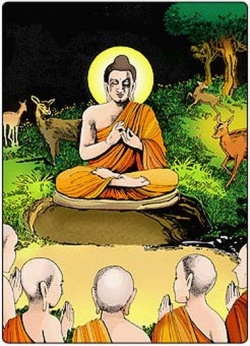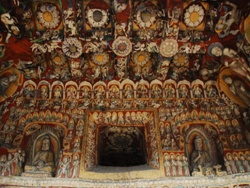Svatantrika
In the philosophy of Tibetan Mahayana Buddhism, specifically in the Madhyamaka view, Svātantrika is a category of Madhyamaka viewpoints attributed primarily to the 6th century Indian scholar Bhavaviveka. It is used in contrast with another such subcategory, Prāsangika Madhyamaka.
The key distinction between these viewpoints is whether one works with assertions about the ultimate nature of reality, or if one refrains completely from doing so. If one works with assertions, then that is a Svātantrika approach. Refraining from doing so is a Prāsangika approach.
Besides the technical definitions, the styles of the different approaches are notable. Svatantrika style approaches have a more structured syllogistic form, making assertions with argumentation, whereas the Prasangika approach may make assertions, but with significantly less reasonings for those assertions. Instead they mainly point out errors resulting from taking reasonings to logical extremes.
History
The Prāsangika / Svātantrika distinction represents a native Tibetan interpretation of Indian disputes among Nāgārjuna commentators
Buddhapalita (whom Tibetan tradition credits as the founder of the Prasangika "school");
Bhāvaviveka (whose criticisms of Buddhapalita are retrospectively imagined as the foundation of the Svatantrika "school"); and
Chandrakirti (who defended Buddhapalita against Bhavaviveka, and is therefore associated with Prasangika).
Note that none of these "schools" seem to have existed in ancient India, but were created after the fact by Tibetan doxographers. For that matter the very name "Svātantrika" represents a back-translation into Sanskrit, coined by modern scholars, for the Tibetan term rang rgyud ba.
The term refers to Bhāvaviveka's criticism that Buddhapalita ought not to have relied solely on reductio ad absurdum arguments—hence the name "Prāsangika", from prāsanga ("consequence")—but ought to have set forth "autonomous" (svātantra) syllogisms of his own. (Whether a Madhyamaka viewpoint would allow the necessary factual claims, or statements of epistemological principles, for such an argument was the major point in dispute.) Dreyfus and McClintock observe:
In this regard, Bhāvaviveka should probably be seen as quite successful: apart from Candrakirti and Jayananda, nearly all other Indian Madhyamikas were to follow in his footsteps and embrace autonomous arguments as important tools in their endeavors to establish the supremacy of the Madhyamaka view."
The name of the inventor of the Prāsangika / Svātantrika distinction is not known. One possible candidate is the 11th-century Tibetan translator of Candrakirti, Patsap Nyima Drak (Wylie: Pa sthab nyi ma grags). The rise of Prāsangika can be attributed to the influence of Tsongkhapa, the Gelugpa founder, who ironically sides with Svātantrika writers on several important points (including the necessity of proposing formal theses as part of a logical argument).
As interpreted by Tibetan writers such as Tsongkhapa, the Prāsangika / Svātantrika distinction involved not only issues of logic, but also affected the two schools' respective understandings of sunyata ("emptiness"). However, mainstream Sakya's (following Rongtön and Gorampa) hold the position that the distinction between these two schools is merely of pedagogical nature. With regard to the view of the ultimate truth both have no difference.
Subdivisions
Before the Prāsangika / Svātantrika distinction rose to prominence, other divisions of Madhyamaka were proposed. Yeshe De (Wylie: Ye shes sde; 8th–9th centuries) posited two alternative categories:
"Sautrantika Madhyamika," including Bhavaviveka; and
"Yogācāra Madhyamaka," including Shantarakshita, Kamalasila, and Haribhadra.
Later Gelugpa scholars as well as Nyingmapa's considered both of the above to constitute subdivisions of Svatantrika, however, under the names of
"Sautrantika Svātantrika Madhyamaka"; and
"Yogācāra Svātantrika Madhyamaka."
The preferred Gelugpa approach, Prāsangika, was represented chiefly by Candrakirti. Classical Indian commenters did not acknowledge Candrakirti as an important Nāgārjuna commentator, but the Tibetan tradition after the 14th century considers his commentary critical. Though lacking a formal categorization, there are key differences between the viewpoint of Tsongkhapa's interpretation of Prāsangika and earlier forms of Prāsangika.
Enumerated ultimate
A further distinction exemplified between views by Shantarakshita was the process of using an enumerated or approximate ultimate as a contemplation, such as only negating existence but not yet relating to non-existence or other extremes, as a way to develop one's view before working with the final contemplations of going beyond all extremes concurrently. The approach of working with an enumerative ultimate first would fit within the Svatantrika view since it uses autonomous arguments whereas the final contemplations is in accord with and—according to Ju Mipham—as efficacious the Prasangika approach.
Scriptural interpretation
Addressing the Three Turnings of the Wheel of Dharma, Ian Charles Harris reports that "Bhāvaviveka held the third turning to reflect the teaching of the Sandinirmocanasutra ,Sutra of Unraveling the Thought, the scripture which is the basis for the doctrine of the Three Turnings) while the third was in conformity with the Prajñāpāramitā corpus."
Debates
Je Tsongkhapa in the 14th century critiqued the Svatantrika viewpoint. He asserted that because the Svatantrika conventionally establish things by their own characteristics, that they do not arrive at a complete understanding of emptiness. So he asserted that not only were their methods different but also that students using Svatantrika do not achieve the same realization as those using the Prasangika approach. Sakya and Kagyu scholars argued against this interpretation. An ongoing debate about these points continues.
As a result of Je Tsongkhapa's view, the Gelugpa lineage establishes a sort of ladder of progressively refined worldviews and identify the Svatantrika view as inferior to the Prasangika. His critics variously claim that there is no difference in the realization of those using the Svatantrika and Prasangika approaches and that the Svatantrika approach is better for students who are not able to understand the more direct approach of Prasangika but it nonetheless results in the same ultimate realization.
According to the Nyingma lineage, an amusing critique by Ju Mipham of Je Tsongkhapa's assertion was to argue that Je Tsongkhapa was also a Svatantrika because of the way he refutes true establishment instead of objects themselves. Further, Ju Mipham argues that Je Tsongkhapa's approach is an excellent Svatantrika approach that leads students further but will not lead to the true ultimate until they go further.
The debate is also not strictly along lineage lines, there are some non-Gelugpa's who prefer Je Tsongkhapa's points and a notable Gelugpa, Gendün Chöphel, preferred and wrote about Ju Mipham's interpretation.
The debate between proponents of Prasangika and Svatantrika somewhat resembles the debates of proponents of shentong (empty of other) and rangtong (empty of self) views but they are separate distinctions.
See Also: Sautrantika
ka ma la shi la - 1) Kamalashila. 2) Indian disciple of Khenpo Shantarakshita. {pad ma'i ngang tshul} 8th century Indian master of Svatantrika Madhyamika who visited Tibet and defeated the Chinese monk Hva-Shang in debate. Disciple of Shantarakshita and invited to Tibet by King Trisong Deutsen. proponent of Svatantrika [RY]
grol sde - proponent of Svatantrika [RY]
sgyu ma don dam par 'dod pa'i dbu ma rang rgyud pa - Svatantrika School Asserting Ultimate Illusion [RY]
thag na - proponent of Svatantrika [RY]
mdo sde spyod pa'i dbu ma rang rgyud pa - sutra autonomy middle way school. [a branch of Svatantrika-Madhyamaka. [RY]
rnam grangs pa'i don dam - specified; [can be counted and defined as such and such, nonarising etc.] categorized / enumerated ultimate. one of {don dam bden pa gnyis} ultimate reality that can be expressed in words, from the Yogachara-Svatantrikas [RY]
rnam grangs min pa'i don dam - categorized / unenumerated ultimate, the Ultimate Truth which cannot be expressed in words, from the Yogchara-Svatantrikas [RY]
rnal 'byor spyod pa'i dbu ma rang rgyud pa - the Yogacara, Madhyamaka Svatantrika, The line of thought [strongly mentalistic-phenomenalistic] initiated by Shantarakshita and his disciple Kamalashila which synthesized the Madhyamaka svatantrika line [of Bhavaviveka with the understanding of the Yogacara school [RY]
dpal sbas - see {slob dpon dpal sbas} most glorious; proponent of Svatantrika [RY]
dbu ma rang rgyud - Svatantrika-Madhyamaka [RY]
dbu ma rang rgyud gong ma - the Higher Madhyamika Svatantrika. [Syn. {rab tu mi gnas pa} [RY]
dbu ma rang rgyud pa - Svatantrika Madhyamaka School [RY]
dbu ma rang rgyud pa - Middle way autonomy school. Svatantrika-Madhyamika, [is divided into {sgyu ma don dam pa}, {rab tu mi gnas pa}. dogmatists centrist [RY]
mar me mdzad bzang po - proponent of Svatantrika [RY]
sman zhabs - proponent of Svatantrika; Vitapaada [RY]
zhi ba 'tsho - proponent of Svatantrika; Indian pandita, first half of 8th century. Shantarakshita [RY]
ye shes snying po - proponent of Svatantrika; the master Jnanagarbha, guru of Marpa, the Sarvastivadin scholar who ordained and named Bodhisattva Shantarakshita / {mkhan po zhi ba 'tsho} a disciple and precept-successor in the Vinaya lineage of {slob dpon dpal sbas} The guru of Bodhisattva Shantarakshita [RY]
ye shes zhabs - proponent of Svatantrika [RY]
rang rgyud gong ma - Higher Svatantrika School [RY]
rang rgyud pa -
1) one who relies on autonomous inferences svantantra to refute true existence.
2) a Madhyamika who asserts that, conventionally, phenomena are naturally existent.
3) a dogmaticist, svantantrika.
4) [substance-grasping] as in {rnam rtog} Syn {tha mal pa}
5) see {dbu ma rang rgyud pa}
6) independently existent Syn {rang mtshan pa}
7) ordinary. (to be inherently endowed with an) autonomous (mind-stream);
Svatantrika. Def. by Jamgön Kongtrül: {legs ldan 'byed kyi rjes 'brang tha snyad du chos thams cad skye ba med pa dang stong pa nyid la sogs pa rang lugs su khas blangs nas/ tshul gsum dngos stobs kyis grub pa'i rang rgyud kyi gtan tshigs gtso bor sgrub byed du 'god pa'i phyir rang rgyud pa zhes bya} [RY]
rang rgyud pa - Svatantrika. Branch of the Madhyamaka, distinguished by use of conventional forms of philosophical reasoning [RY]
rang rgyud pa brgyad - the eight Svatantrika systems / schools [RY]
rang rgyud pa'i rnam gzhag - the Svatantrika system [RY]
rang rgyud pa'i lugs - the Svatantrika system [RY]
rang rgyud 'og ma - the Lower Svatantrika School, Lower Svantantrika [RY]
rang rgyud lugs - the Svatantrika system [RY]
rab tu mi gnas pa'i dbu ma rang rgyud pa - Svatantrika School of Complete Nondwelling [RY]
legs ldan 'byed - Bhavaviveka, a disciple and precept-successor of Nagarjuna. Founder of Svatantrika. founder of {mdo sde'i dbu ma} Sautrantika-Madhyamaka [RY]
legs ldan 'byed - Bhavaviveka, Indian pandita to whom the Svatantrika Madhyamika system owes its origin [first half of 5th century] [RY]
seng bzang - proponent of Svatantrika [RY]
slob dpon bha bya'am legs ldan byed - proponent of Svatantrika [RY]



